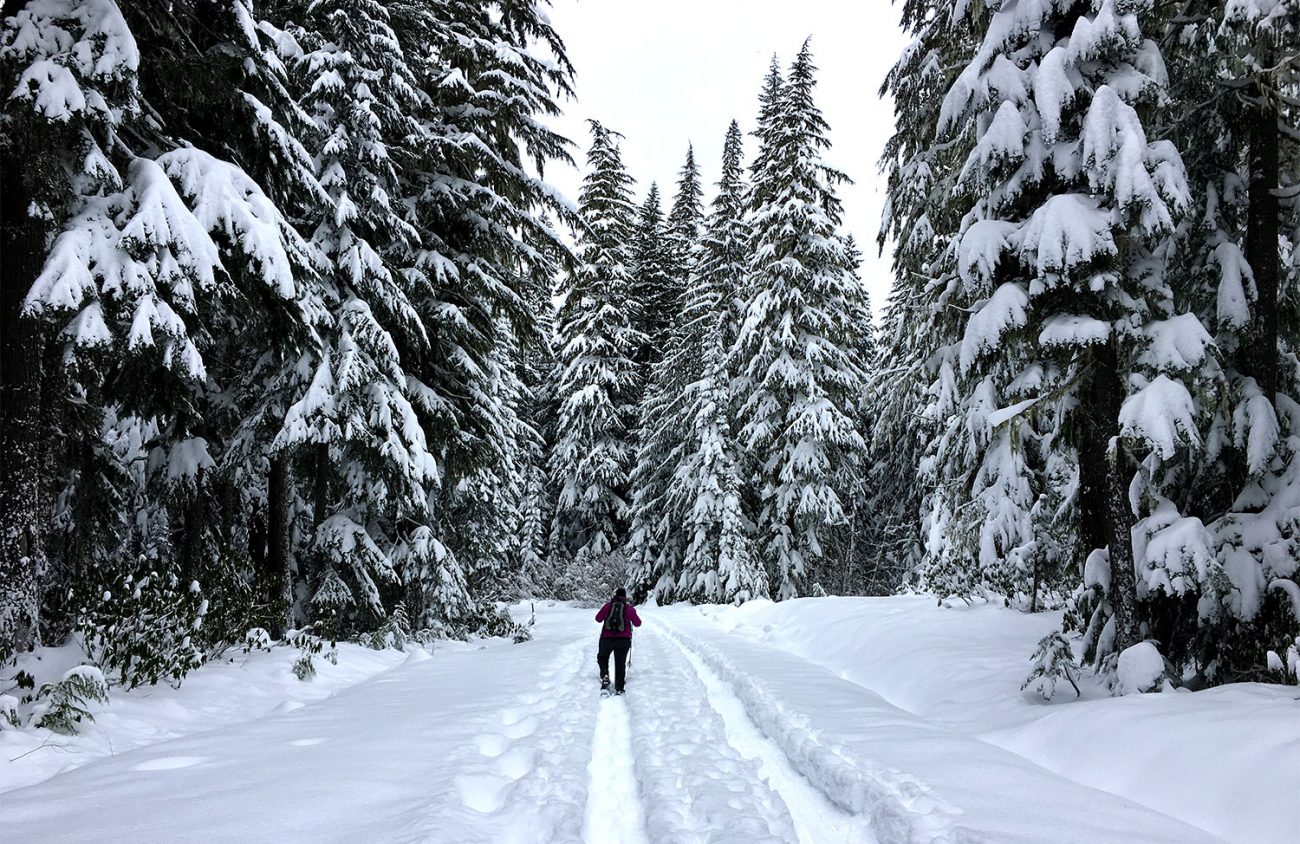I don’t particularly like winter. Growing up in Michigan, I remember waiting for the bus at the end of my rural driveway, shivering after trudging through fresh snow or sliding on ice on far more days than I liked. I didn’t realize until I moved to Eugene 20 years ago that one could choose to visit snow in the mountains — and potentially enjoy it.
In fact, I do enjoy playing in the snow now. Not just because it’s brisk and bright (and a freely chosen, limited-time experience) but also because it’s an opportunity to see the forests, mountains and streams I love in a whole new light. There are mysterious animal tracks in the snow to follow and wonder over; twisted shapes of trees covered in mounds of snow and icy sculptures; and streams and lakes transformed by winter’s frost.
While skiing can be a great way to experience winter trails, I find snowshoeing to be more my speed. Snowshoes are pretty inexpensive (as winter sports gear goes) either to buy or rent; and, as far as special skills, if you can walk, you can snowshoe. The gear you need isn’t super specialized either: You can just strap snowshoes to regular waterproof hiking boots; and as long as you wear layers and have a waterproof outer layer, you should stay warm and dry.
One of my favorite places to snowshoe is from the Salt Creek Sno-Park, five miles west of Willamette Pass. To get there, follow Highway 58 southeast from Eugene through Oakridge.
Go another 23 miles, and about a mile past the tunnel, at mile post 57 and a sign for the Sno-Park, turn right. Then turn left to cross a bridge and continue to the parking area, where you’ll find a vault toilet. A Sno-Park pass is required to park (available at outdoor retailer locations, Bi-Mart and the DMV). Be sure to check the weather and road conditions at tripcheck.com and be prepared with snow tires, chains and other winter gear if necessary.
For an easy “get the hang of it” snowshoe hike, walk back across the bridge you drove in on and turn left. When you reach the unplowed area near the gate, it’s time to put on your snowshoes — it’s never graceful, but most are pretty straightforward to strap on. Pass through the gate, and you’re on the road to Salt Creek Falls.
This is a great place to practice winter trail etiquette — forming or following a snowshoe track that is separate from ski tracks. In about a half mile, you’ll reach the circle drive for the Salt Creek Observation Area. Take either way and follow tracks and signs for the waterfall overlook.
If you’ve seen the astounding 285-foot Salt Creek Falls in the summer, be prepared for something quite different. Ice from frozen spray covers the canyon, the trees are draped in white, and the steep dropoff is even more dangerous. Really, be very careful: The stairs can be very slippery, and the railing is less protective the higher the snow level is.
If this isn’t enough of an adventure or work out for you, follow Salt Creek upstream and look for the blue diamonds and signs for the Diamond Creek Falls loop. You’ll cross a bridge over Salt Creek and then come to a trail intersection in the forest. To do the three-mile Diamond Creek Falls loop from here, turn left at this junction and follow the blue diamond-marked trail into a lovely forest, skirting Too Much Bear Lake and climbing — challenging, but worthwhile — to a road.
Cross the road and pick up the trail on the other side and follow it until it crosses the road again and heads downhill. Soon, you’ll approach the Diamond Creek Falls viewpoint, where you can glimpse the beautiful stream cascading 100 feet down an icy rock face. From here, the loop takes you downhill through the forest, and then to a viewpoint overlooking the Salt Creek canyon before you complete the loop back to the wooded intersection. Turn left to head back to the Salt Creek Observation Area loop and the road back to the Sno-Park. The total distance is a little over four miles.
Winter weather does add a few more concerns and considerations for getting outdoors, but it can be really rewarding. A few snowshoeing tips can help you have the best experience:
• Snowshoeing is more strenuous than hiking, especially in fresh snow. Go slow to keep your breath in check and not get your layers too sweaty. Remember to drink water to avoid dehydration, even if you don’t feel hot.
• Look for winter signs of wildlife like tracks and piles of seeds.
• Play “off trail” in the fresh snow to really see how snowshoes work — just keep an eye on the blue diamonds so you don’t get lost, and stay away from tree wells and stream banks to avoid falling in.
• To go up or downhill safely, use the spiked parts of your snowshoe for traction. When climbing over obstacles, keep your floppy shoes and those spikes in mind so you don’t hurt yourself or your snowshoeing friends.
Chandra LeGue of Eugene is the author of the book Oregon’s Ancient Forests: A Hiking Guide and is the Western Oregon field coordinator for Oregon Wild, where she advocates for the protection and restoration of Oregon’s forests and wild places. You can join Chandra on this hike Jan. 25. Go to OregonWild.org to sign up.
